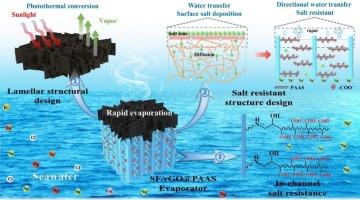Silk-based polyelectrolyte evaporator with excellent salt resistance for high-rate and stable solar desalination
IF 8.3
1区 工程技术
Q1 ENGINEERING, CHEMICAL
引用次数: 0
Abstract
Solar-driven interfacial evaporation technology is a promising solution to solve global freshwater shortages through desalination. However, salt accumulation in the evaporator affects light absorption and reduces evaporation efficiency, thereby significantly reducing the service life and operating efficiency of the evaporator. Herein, we propose a strategy for sustainable salt resistance that enables strong salt resistance and rapid water delivery by in situ polymerization of sodium acrylate (PAAS) on the directional channel. As a result, the as-prepared SF/rGO@PAAS can achieve a high evaporation rate of up to 2.31 kg m−2 h−1 and high evaporation efficiency of up to 98% under one sun, benefiting from the inherent hydrophilicity of silk fibroin (SF), the directional channel design of water transport layer, and the efficient solar light absorption in full spectrum of reduced graphene oxide (rGO). More importantly, due to the electrostatic effect of PAAS, the evaporator showed excellent salt resistance, with no salt precipitation for 5 days of continuous evaporation in simulated seawater (3.5 wt%) while maintaining the high evaporation rate. This salt resistant evaporator provides an effective solution to the salt accumulation and addresses a key challenge in sustainable desalination.

丝基聚电解质蒸发器具有优异的耐盐性,可用于高速稳定的太阳能海水淡化
太阳能驱动的界面蒸发技术是通过海水淡化解决全球淡水短缺问题的一个前景广阔的解决方案。然而,蒸发器中的盐分积累会影响光的吸收,降低蒸发效率,从而大大降低蒸发器的使用寿命和运行效率。在此,我们提出了一种可持续抗盐战略,通过在定向通道上原位聚合丙烯酸钠(PAAS),实现强抗盐性和快速输水。因此,得益于蚕丝纤维素(SF)固有的亲水性、水传输层的定向通道设计以及还原氧化石墨烯(rGO)对全光谱太阳光的高效吸收,所制备的 SF/rGO@PAAS 在一太阳光下可实现高达 2.31 kg m-2 h-1 的高蒸发率和高达 98% 的高蒸发效率。更重要的是,由于 PAAS 的静电效应,该蒸发器表现出优异的耐盐性,在模拟海水(3.5 wt%)中连续蒸发 5 天也没有盐分析出,同时还能保持较高的蒸发率。这种耐盐蒸发器为盐分积累提供了有效的解决方案,并解决了可持续海水淡化的一个关键难题。
本文章由计算机程序翻译,如有差异,请以英文原文为准。
求助全文
约1分钟内获得全文
求助全文
来源期刊

Desalination
工程技术-工程:化工
CiteScore
14.60
自引率
20.20%
发文量
619
审稿时长
41 days
期刊介绍:
Desalination is a scholarly journal that focuses on the field of desalination materials, processes, and associated technologies. It encompasses a wide range of disciplines and aims to publish exceptional papers in this area.
The journal invites submissions that explicitly revolve around water desalting and its applications to various sources such as seawater, groundwater, and wastewater. It particularly encourages research on diverse desalination methods including thermal, membrane, sorption, and hybrid processes.
By providing a platform for innovative studies, Desalination aims to advance the understanding and development of desalination technologies, promoting sustainable solutions for water scarcity challenges.
 求助内容:
求助内容: 应助结果提醒方式:
应助结果提醒方式:


